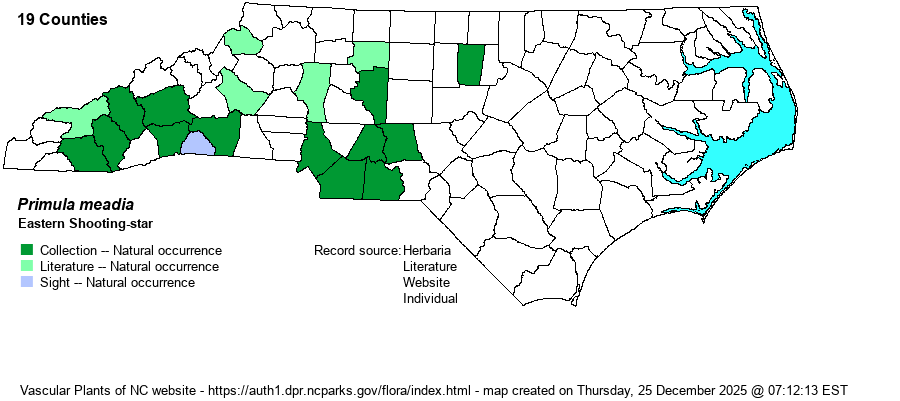| Section 6 » Family Primulaceae |
Show/Hide Synonym
| taxonName | relationship | relatedTaxonName | relatedTaxonRefText | relComments |
|---|
|
|
|
|
|
| Primula meadia | = | Dodecatheon meadia | Flora of North America (1993b, 1997, 2000, 2002a, 2002b, 2003a, 2004b, 2005, 2006a, 2006b, 2006c, 2007a, 2009, 2010) | | | Primula meadia | = | Dodecatheon meadia | | | | Primula meadia | = | Dodecatheon meadia | | | | Primula meadia | = | Dodecatheon meadia | Radford, Ahles, and Bell (1968) | | | Primula meadia | = | Dodecatheon meadia | Wofford (1989) | | | Primula meadia | = | Dodecatheon meadia | Flora of West Virginia | | | Primula meadia | > | Dodecatheon meadia var. meadia | Gleason and Cronquist (1991) | | | Primula meadia | > | Dodecatheon meadia var. meadia | Fernald (1950) | | | Primula meadia | > | Dodecatheon meadia var. meadia | Gleason (1952) | | | Primula meadia | > | Dodecatheon meadia var. meadia | Mast et al. (2004). | | | Primula meadia | > | Dodecatheon meadia var. brachycarpum | Gleason and Cronquist (1991) | | | Primula meadia | > | Dodecatheon meadia var. brachycarpum | Fernald (1950) | | | Primula meadia | > | Dodecatheon meadia var. brachycarpum | Gleason (1952) | | | Primula meadia | > | Dodecatheon meadia var. brachycarpum | Mast et al. (2004). | | | Primula meadia | > | Dodecatheon meadia ssp. meadia | | | | Primula meadia | > | Dodecatheon meadia ssp. brachycarpum | | | | Primula meadia | > | Dodecatheon brachycarpa | Small (1933, 1938) | | | Primula meadia | > | Dodecatheon meadia | Small (1933, 1938) | | | Primula meadia | > | Dodecatheon hugeri | Small (1933, 1938) | | | Primula meadia | > | Dodecatheon meadia var. genuinum | Mast et al. (2004). | | | Primula meadia | > | Dodecatheon meadia var. obesum | Mast et al. (2004). | | | Source: Weakley's Flora |
|
| Author | (L.) A.R. Mast & Reveal | |
| Distribution | Present over much of the central and southern Mountains and central-western Piedmont, east to Forsyth, Davidson, Montgomery, and Anson counties; disjunct (natural?) to Orange County. Oddly, considering this is a somewhat Midwestern species, nearly all records for the Mountains are from the southern half. Photos on iNaturalist for the central and eastern Piedmont are not added to the map owing to possibility of local plantings.
This species ranges from PA to MN and south to central GA, western FL, and northeastern TX.
| |
| Abundance | Rare to uncommon in the southern Mountains, from Buncombe to Macon counties and east to Rutherford County. Rare (and very poorly protected) in the southern Piedmont, and very rare to absent in the northern Piedmont and northern Mountains. It is a State Special Concern species. | |
| Habitat | This species is limited to quite rich (or at least high pH) soil, in several distinct habitats. It is most frequent in Rich Cove Forests and Basic Mesic Forests; however, it also grows on bluffs or around other rock outcrops where the soil is of high pH, such as around amphibolite outcrops. It may grow rarely in glades or seepages. For whatever reason, the very rich soils in the Amphibolite Mountains in the northern mountains are almost devoid of this species. |
| Phenology | Blooms from late March to early June, and fruits from late May through June. | |
| Identification | This is one of the most unusual and striking of our wildflowers, unfortunately not at all numerous, though most people will have seen the species in gardens or other plantings. It has a rosette of very long leaves, longer than in most species, and instead of hugging the ground, most or all are ascending. These are entire, mostly oblanceolate (wider above the middle), with a rounded tip and narrowed to the base, about 8 inches long and 2 inches wide. The flowering scape grows to about 1-1.5 feet tall, with a cluster (5-15) of striking white flowers. Each flower is on a very slender and recurved pedicel of 1-2 inches long, such that the flower gracefully is pointing downward. The petals (occasionally pink instead of white) are flared back, each being elliptical and about 3/4-inch long, with the stamens extended and facing forward, representing the "front" of the "arrowhead" or "dart" look to each flower. This species is usually identifiable even when just the rosette is visible, as few species have a rosette of leaves often reaching 8 inches long, with leaves ascending. It can grow in moderate stands in NC, though usually not covering large areas like with Lysimachia species. Sadly, despite a number of Piedmont locations, many are historical and very, very few are in protected natural areas. Thankfully, many Mountain sites are somewhat protected on Federal lands or other conservation lands. | |
| Taxonomic Comments | Most references have used the name of Dodecatheon for this and similar "shooting-star" species. Sadly, these distinctive plants have been dumped into a genus of "about 450 species", according to Weakley (2018); their flowers are quite different and have flowers that are basically flat in a single plane.
| |
| Other Common Name(s) | Shooting-star (a name satisfactory for use in NC, but there are other "shooting-star" species elsewhere) | |
| State Rank | S2S3 | |
| Global Rank | G5 | |
| State Status | SC-V | |
| US Status | | |
| USACE-agcp | | |
| USACE-emp | | |

